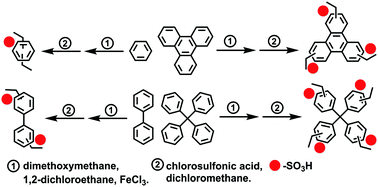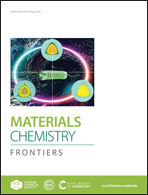Simple and universal synthesis of sulfonated porous organic polymers with high proton conductivity†
Abstract
Along with the rapid development of economic integration and regional economization worldwide, the growth of green and sustainable resources has posed a major concern. Proton-exchange membrane fuel cells (PEMFCs) are examples of green, resource-conserving, and environmentally protective energy resources. Porous organic polymers (POPs), a new class of porous materials with high porosity, permanent pores, excellent stability, and easily modified functional units, can offer a good platform as proton-conducting electrolytes for fuel cells. However, a simple and general design to construct POPs with high proton conductivity presents a challenging project. For this study, we used simple benzene and aromatic benzene as building units through a facile and cost-effective process to create a series of POPs. We further prepared sulfonated POPs (S-POPs) with high-density sulfonic acid groups via post-sulphonation. The S-POPs displayed excellent proton conductivity up to 10−2 S cm−1 at 25 °C and 95% relative humidity (RH), and high conductivity up to 10−1 S cm−1 at 80 °C and 95% RH, which ranked top among the most proton-conducting POPs. These results suggest that construction of S-POPs offers a simple and universal way to evolve structural designs for high proton-conductive materials.

- This article is part of the themed collection: 2020 Materials Chemistry Frontiers HOT articles


 Please wait while we load your content...
Please wait while we load your content...